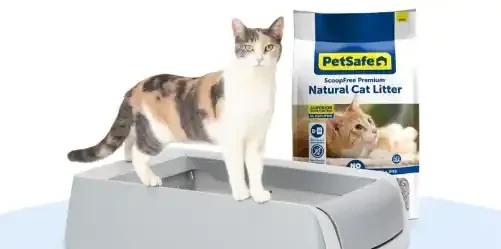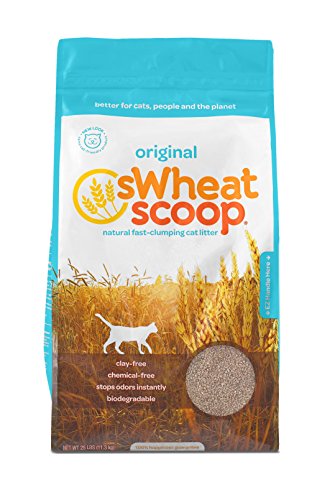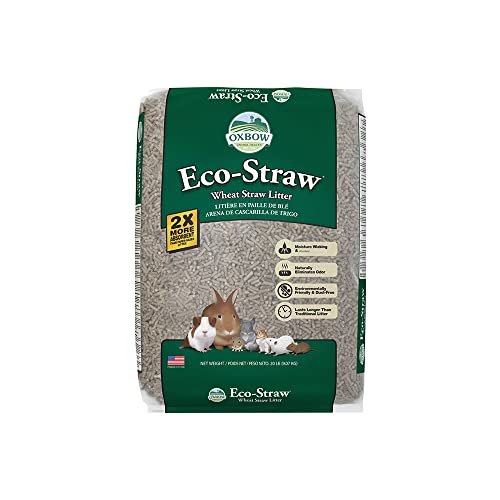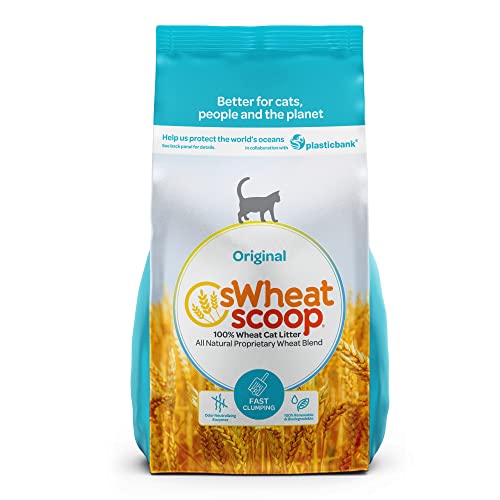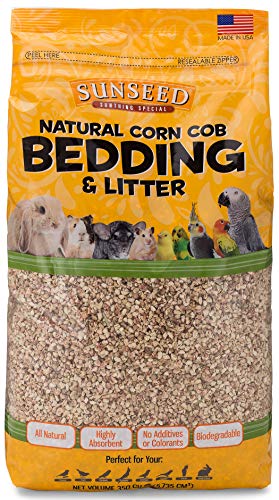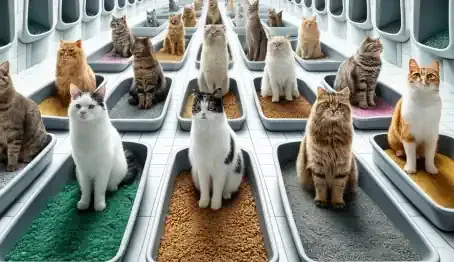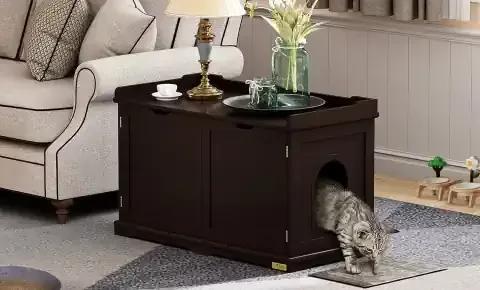Cats, those beloved companions with their playful antics and soothing purrs, have nestled their way into the hearts of millions worldwide. As integral members of our families, it's our responsibility as pet owners to ensure their well-being, comfort, and health. One critical aspect of feline care often overlooked is their toileting needs, which bring us to the ubiquitous world of cat litter.
Cat litter serves as more than just a convenience; it's a necessity for both indoor and outdoor felines. This granular substrate provides a designated area for cats to relieve themselves, mimicking their natural inclination to bury their waste. Beyond mere practicality, cat litter plays a crucial role in maintaining a clean and odor-free living environment for both humans and their furry companions.
Historically, cat litter has primarily been synonymous with clay-based products. However, in recent years, there has been a notable shift towards more eco-conscious and natural alternatives. This transition is not merely a passing trend but a reflection of a broader societal movement towards sustainability and environmental stewardship.
In this article, we delve into the realm of natural cat litter, exploring its composition, benefits, and considerations for both feline and human health. We'll compare traditional clay-based litters with their natural counterparts, examining the environmental impact, health implications, and performance metrics. Additionally, we'll offer practical advice on selecting the right natural cat litter for your pet, as well as tips for seamlessly transitioning to these eco-friendly options.
As conscientious consumers, it's essential to be informed about the products we bring into our homes, especially those that directly impact the well-being of our beloved pets. By exploring the world of natural cat litter, we empower ourselves to make choices that align with our values of sustainability, health, and compassion towards our furry companions. So, let's embark on this journey to discover the wonders of natural cat litter and how it can revolutionize the way we care for our feline friends.
Traditional Cat Litter vs. Natural Cat Litter
Composition and Ingredients
Traditional cat litter, predominantly made from clay, has been the go-to choice for cat owners for decades. This type of litter typically consists of sodium bentonite clay, which is highly absorbent and forms tight clumps when wet. While effective in controlling odors and facilitating easy waste removal, clay-based litters come with their fair share of environmental and health concerns.
Traditional Clay-Based Litters
Sodium Bentonite Clay: This type of clay is mined from the earth's surface and processed into granules suitable for cat litter. Its exceptional absorbency makes it a popular choice among cat owners, as it forms solid clumps upon contact with moisture, making waste removal a breeze.
Environmental Impact: The extraction and processing of sodium bentonite clay contribute to habitat destruction, soil erosion, and water pollution. Additionally, the non-biodegradable nature of clay litter means that discarded waste ends up in landfills, where it remains indefinitely.
Natural Alternatives
Plant-Based Litters: Derived from renewable resources such as corn, wheat, or pine, plant-based litters offer an eco-friendly alternative to traditional clay litters. These litters are biodegradable, compostable, and often boast excellent odor control properties.
Paper-Based Litters: Made from recycled paper or newspaper, paper-based litters are lightweight, absorbent, and environmentally friendly. They are an ideal choice for environmentally conscious cat owners looking to minimize their ecological footprint.
Wood-Based Litters: Utilizing by-products from the lumber industry, wood-based litters offer a sustainable alternative to clay. Products such as pine pellets or sawdust are absorbent, naturally fragrant, and biodegradable.
Environmental Impact
Mining and Processing of Clay
Habitat Destruction: The extraction of clay often involves strip mining, which can lead to the destruction of natural habitats and ecosystems. This disruption can have detrimental effects on local flora and fauna, contributing to biodiversity loss.
Resource Depletion: Clay is a finite resource, and its indiscriminate extraction can lead to depletion of natural reserves, exacerbating environmental degradation and land-use conflicts.
Biodegradability and Renewable Resources
Sustainable Sourcing: Natural cat litters, such as those made from plant-based or recycled materials, rely on renewable resources that can be replenished over time. By utilizing sustainable sourcing practices, these litters minimize the environmental impact associated with their production and disposal.
Biodegradability: Unlike traditional clay litters, which persist in landfills indefinitely, natural litters break down over time, returning nutrients to the soil and reducing the burden on waste management infrastructure.
Health Considerations
Dust and Respiratory Health
Clay Dust: Traditional clay litters can generate significant amounts of dust when disturbed, posing respiratory health risks to both cats and their owners. Prolonged exposure to airborne dust particles can exacerbate respiratory conditions such as asthma and allergies.
Low-Dust Alternatives: Natural cat litters, particularly those made from plant-based or paper materials, tend to produce less dust, creating a healthier environment for cats and humans alike.
Chemical Additives and Allergies
Artificial Fragrances: Many conventional cat litters contain artificial fragrances and chemical additives designed to mask odors. However, these synthetic compounds can trigger allergic reactions in sensitive individuals and may be harmful to pets with respiratory issues.
Natural Fragrance Options: Natural cat litters often utilize botanical extracts or essential oils to provide odor control without relying on synthetic fragrances. These natural alternatives are gentler on the respiratory system and reduce the risk of allergic reactions.
By comparing the composition, environmental impact, and health considerations of traditional clay-based litters with natural alternatives, cat owners can make informed choices that prioritize the well-being of their pets and the planet. In the following sections, we will delve deeper into the specific benefits of natural cat litter, exploring their eco-friendliness, health benefits, and performance compared to traditional options.
Benefits of Natural Cat Litter
As the awareness of environmental sustainability and pet health grows, natural cat litter options have gained popularity among cat owners seeking eco-friendly and healthier alternatives to traditional clay-based litters. In this section, we explore the myriad benefits of natural cat litter, ranging from eco-friendliness to improved respiratory health for both cats and their human companions.
Eco-Friendliness
Reduced Carbon Footprint
Natural cat litters, derived from renewable resources such as plant fibers or recycled materials, have a significantly lower carbon footprint compared to clay-based litters. By utilizing sustainable sourcing practices and minimizing the reliance on non-renewable resources, these litters help mitigate environmental degradation and combat climate change.
The production of natural cat litter involves fewer energy-intensive processes and reduces the demand for raw materials extracted from the earth, thereby conserving natural habitats and preserving biodiversity.
Sustainable Sourcing
Many natural cat litters are made from agricultural by-products or recycled materials that would otherwise end up in landfills. By repurposing these resources, manufacturers reduce waste and minimize the environmental impact associated with their disposal.
Sustainable sourcing practices ensure that natural cat litters are produced ethically and responsibly, prioritizing the long-term health of ecosystems and communities.
Health Benefits
Reduced Exposure to Harmful Chemicals
Traditional clay-based litters often contain artificial fragrances, chemical binders, and other additives that may pose health risks to cats and humans. Prolonged exposure to these synthetic compounds can irritate the respiratory system, trigger allergic reactions, and contribute to long-term health issues.
Natural cat litters, on the other hand, are free from artificial fragrances and harsh chemicals, making them a safer and healthier choice for pets and their owners. By opting for natural alternatives, cat owners can minimize the risk of respiratory problems and allergies associated with chemical exposure.
Better Respiratory Health for Cats and Owners
Dust control is a significant concern for cat owners, particularly those with respiratory sensitivities or allergies. Traditional clay litters often generate fine dust particles when disturbed, which can exacerbate respiratory conditions in both cats and their human companions.
Natural cat litters, formulated to be low-dust or dust-free, create a healthier living environment by reducing airborne particulate matter. This is especially beneficial for cats prone to respiratory issues or those living in multi-cat households where litter dust can accumulate.
Odor Control and Absorbency
Comparing Performance with Traditional Litters
Natural cat litters are often praised for their superior odor control and absorbency compared to traditional clay-based litters. Despite being derived from organic materials, these litters effectively neutralize odors and absorb moisture, keeping litter boxes fresher for longer periods.
Plant-based litters, such as those made from corn or wheat, harness natural enzymatic processes to break down odor-causing compounds, resulting in a cleaner and more pleasant-smelling environment.
Natural Ingredients' Impact on Odor Control
Many natural cat litters incorporate botanical extracts or essential oils known for their odor-neutralizing properties. Ingredients like activated charcoal, baking soda, or cedarwood help absorb and eliminate odors naturally, without the need for artificial fragrances or chemical additives.
By harnessing the power of nature, natural cat litters provide effective odor control while minimizing the risk of adverse reactions associated with synthetic fragrances.
In summary, natural cat litters offer a host of benefits ranging from eco-friendliness and improved respiratory health to superior odor control and absorbency. By making the switch to natural alternatives, cat owners can provide their feline companions with a safer, healthier, and more environmentally sustainable litter solution. In the following sections, we'll delve deeper into the considerations for choosing the right natural cat litter and offer practical tips for transitioning seamlessly to these eco-friendly options.
Choosing the Right Natural Cat Litter
Selecting the most suitable cat litter is a crucial decision for pet owners, as it directly impacts the comfort, health, and well-being of their feline companions. With the growing popularity of natural cat litters, there is an abundance of options available on the market, each with its unique characteristics and benefits. In this section, we explore the factors to consider when choosing the right natural cat litter and provide guidance to help pet owners make informed decisions.
Understanding Cat Preferences
Texture and Scent Preferences
Cats are notoriously selective creatures, and their litter preferences can vary widely from one individual to another. Some cats prefer fine-grained litters with a soft texture, while others may favor coarser materials like wood pellets or clumping clay.
Similarly, cats have sensitive noses and may be averse to strong scents or perfumes commonly found in commercial litters. When selecting a natural cat litter, consider your cat's preferences and choose a product with a mild or natural fragrance, if any.
Clumping vs. Non-Clumping
Clumping cat litters form solid clumps when exposed to moisture, making waste removal more convenient and efficient. While many natural litters offer clumping capabilities, some may be non-clumping and require more frequent scooping to maintain cleanliness.
Consider your cat's litter box habits and your cleaning routine when deciding between clumping and non-clumping options. Clumping litters are generally preferred for their ease of use and superior odor control.
Owner Considerations
Budget and Affordability
Natural cat litters often come at a higher price point compared to traditional clay litters due to their eco-friendly sourcing and manufacturing processes. However, it's essential to weigh the long-term benefits and savings associated with natural litters, such as reduced veterinary bills and environmental impact.
Consider your budget and evaluate the cost-effectiveness of different natural cat litter options. While some premium brands may be more expensive upfront, they may offer superior performance and longevity, ultimately saving you money in the long run.
Convenience and Availability
Accessibility and convenience are key factors to consider when choosing a natural cat litter. While many pet stores and online retailers offer a wide selection of natural litters, availability may vary depending on your location.
Evaluate the ease of purchasing and replenishing your preferred litter, taking into account factors such as proximity to stores, online ordering options, and subscription services. Choose a litter that aligns with your lifestyle and accessibility needs to ensure consistent litter box maintenance.
Reviews and Recommendations
Customer Feedback
Before making a purchase, take the time to research and read customer reviews of different natural cat litters. Online platforms and pet care forums are valuable resources for gathering firsthand experiences and insights from fellow cat owners.
Pay attention to reviews regarding odor control, clumping performance, dust levels, and overall satisfaction with the product. Look for patterns and recurring themes in the feedback to gauge the reliability and effectiveness of a particular litter brand.
Expert Opinions and Ratings
Seek recommendations from trusted sources, such as veterinarians, animal behaviorists, and pet care professionals, who can provide expert advice on selecting the right cat litter for your pet.
Look for independent product evaluations and ratings from reputable organizations, such as consumer advocacy groups and pet industry associations. These evaluations often consider factors such as performance, safety, and environmental impact, helping you make an informed decision.
By considering your cat's preferences, your budget, convenience factors, and expert recommendations, you can choose a natural cat litter that meets your pet's needs and aligns with your values of sustainability and environmental responsibility. In the following section, we'll discuss practical tips for transitioning to natural cat litter smoothly and effectively, ensuring a seamless adjustment for both you and your feline companion.
Tips for Switching to Natural Cat Litter
Transitioning to natural cat litter requires careful planning and patience to ensure a smooth adjustment for both you and your feline friend. In this section, we provide practical tips and guidance to help pet owners make the switch effectively and seamlessly.
Gradual Transition Process
Mixing Old and New Litter
Start by gradually introducing the new natural cat litter alongside your cat's existing litter. Mix a small amount of the natural litter with the familiar litter in the litter box, gradually increasing the ratio of natural litter over time.
This gradual transition allows your cat to acclimate to the new texture, scent, and feel of the natural litter without causing undue stress or confusion.
Patience and Reinforcement
Be patient and observant during the transition period, allowing your cat to explore and adjust to the new litter at their own pace. Offer positive reinforcement, such as treats or praise, when your cat uses the litter box with the new litter.
Avoid forcing your cat to use the new litter or scolding them for accidents, as this can create negative associations and resistance to the change.
Monitoring Cat's Reaction
Observing Behavior Changes
Pay close attention to your cat's behavior and litter box habits during the transition period. Look for signs of hesitation, avoidance, or discomfort, which may indicate that your cat is struggling to adapt to the new litter.
Monitor your cat's litter box usage, ensuring they continue to use the box regularly and exhibit normal elimination behavior.
Addressing Any Concerns Promptly
If you notice any issues or concerns during the transition, such as litter aversion or refusal to use the litter box, address them promptly and proactively.
Consider adjusting the litter box setup, trying different natural litter brands or formulations, or consulting with a veterinarian or animal behaviorist for personalized advice and guidance.
Maintaining Cleanliness
Regular Scooping and Cleaning
Maintain a clean and hygienic litter box environment by scooping waste and clumps regularly, ideally at least once or twice daily. Keep the litter box clean and fresh to encourage your cat to use it consistently.
Replace the litter as needed, following the manufacturer's recommendations for frequency and quantity. Natural litters may require more frequent replacement than clay-based litters, depending on their absorbency and odor control properties.
Tips for Managing Odor
Natural cat litters are generally effective at controlling odors, but additional measures may be necessary, especially in multi-cat households or high-traffic areas.
Consider placing a litter box deodorizer or activated charcoal filter near the litter box to absorb odors and maintain a fresher-smelling environment. You can also sprinkle baking soda or natural odor-absorbing additives directly into the litter for added odor control.
By following these tips and strategies, pet owners can facilitate a smooth and successful transition to natural cat litter, promoting their cat's health and well-being while minimizing environmental impact. Remember to be patient, attentive, and adaptable throughout the process, prioritizing your cat's comfort and satisfaction above all else. In the next section, we'll address common concerns and misconceptions about natural cat litter, dispelling myths and providing clarity to help pet owners make informed decisions.
Addressing Common Concerns and Myths
As pet owners consider making the switch to natural cat litter, it's essential to address common concerns and misconceptions that may arise. In this section, we debunk myths surrounding natural cat litter, provide clarity on misconceptions, and offer reassurance to pet owners exploring eco-friendly alternatives for their feline companions.
Cost-Efficiency Over Time
Myth: Natural cat litter is more expensive than traditional clay litter.
Reality: While natural cat litter may have a higher upfront cost, it often proves to be more cost-effective in the long run. Natural litters are typically more absorbent, requiring less frequent replacement and resulting in less overall litter usage over time. Additionally, the potential savings in veterinary bills due to improved respiratory health and reduced exposure to harmful chemicals should be considered when evaluating cost-effectiveness.
Myth: Natural cat litter requires frequent replacement, leading to higher ongoing expenses.
Reality: While some natural cat litters may require more frequent replacement than clay-based litters, this is not universally true for all natural options. Many natural litters offer excellent absorbency and odor control, allowing them to maintain freshness for extended periods. By choosing the right natural litter and implementing proper litter box maintenance practices, pet owners can minimize the frequency of litter replacement and associated costs.
Effectiveness in Multi-Cat Homes
Myth: Natural cat litter is less effective than traditional clay litter in multi-cat households.
Reality: Natural cat litters can be just as effective, if not more so, than traditional clay litter in multi-cat environments. Many natural litters are formulated to handle high-traffic litter boxes and multiple cats, offering superior odor control and clumping performance. By selecting a high-quality natural litter and ensuring proper litter box maintenance, pet owners can maintain a clean and hygienic environment for all their feline companions.
Myth: Cats may refuse to use natural litter, leading to litter box aversion and accidents.
Reality: While some cats may initially show reluctance to use a new type of litter, this is usually temporary and can be overcome with patience and gradual introduction. By following the transition tips outlined earlier and offering positive reinforcement, most cats can adapt to natural litter without issue. Additionally, experimenting with different natural litter brands and formulations can help find the right fit for your cat's preferences.
Dispelling Misconceptions about Natural Litters
Myth: Natural cat litter is less effective at controlling odors compared to traditional clay litter.
Reality: Many natural cat litters offer excellent odor control properties, harnessing natural ingredients such as activated charcoal, baking soda, or plant enzymes to neutralize odors effectively. While some natural litters may require more frequent scooping or replacement to maintain freshness, they can still provide comparable or superior odor control to clay-based litters.
Myth: Natural cat litter is messy and difficult to clean up.
Reality: Natural cat litters come in a variety of textures and formulations, ranging from clumping to non-clumping, fine-grained to pellet-style. By selecting a litter that suits your cat's preferences and litter box setup, you can minimize mess and simplify cleanup. Many natural litters are designed to be low-dust and track-resistant, reducing litter scatter and making cleanup easier for pet owners.
By addressing these common concerns and dispelling myths surrounding natural cat litter, pet owners can make informed decisions based on facts and evidence. Ultimately, the choice to switch to natural litter is a personal one, influenced by considerations such as sustainability, environmental impact, and the health and well-being of their feline companions. In the concluding section, we summarize the key points discussed in this article and reiterate the benefits of choosing natural cat litter for both pets and the planet.
Embracing the Benefits of Natural Cat Litter
In the journey to provide the best care for our beloved feline companions, the choice of cat litter plays a pivotal role in promoting their health, comfort, and well-being. Throughout this article, we've explored the transition from traditional clay-based litters to natural alternatives, delving into the myriad benefits and considerations for pet owners.
As conscientious consumers, it's imperative to recognize the environmental impact of our purchasing decisions and strive towards more sustainable choices. Natural cat litter offers a compelling solution for eco-minded pet owners, leveraging renewable resources and minimizing the ecological footprint of litter disposal. By opting for natural alternatives, we contribute to the preservation of natural habitats, reduce carbon emissions, and promote a healthier planet for future generations.
Furthermore, the health benefits of natural cat litter extend beyond environmental sustainability, encompassing improved respiratory health for both cats and their human companions. By eliminating harsh chemicals, artificial fragrances, and dust associated with traditional litters, natural alternatives create a safer and more comfortable living environment for all.
While the transition to natural cat litter may present initial challenges and adjustments, the long-term benefits far outweigh the temporary hurdles. By following the tips and guidance outlined in this article, pet owners can navigate the transition smoothly and ensure a seamless adjustment for their feline friends.
In closing, let us embrace the opportunity to make a positive impact on the world around us by choosing natural cat litter. By prioritizing sustainability, health, and well-being, we not only enrich the lives of our furry companions but also contribute to a greener, more sustainable future for all. Together, let's take a step towards a cleaner, healthier planet, one litter box at a time.
